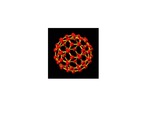IntroductionWhat are nanomaterials?Nanomaterials have unanimously settled on a precise definition given by Scientists. They are partially characterized by their small size in nanometers. One millionth of a millimeter approximately 100,000 times smaller than the diameter of a human hair is called nanometer.From a variety of products nano-sized particles exist in nature and can be created, for instance, carbon or minerals like silver, but nanomaterials by definition must have at least one dimension less than approximately 100 nanometers. Most of the nanoscale materials are too small to be seen with the naked eye and even with conventional lab microscopes.Upon converting the nanomaterials as engineered materials from a variety of products they have shown unique optical, magnetic, electrical, and other properties. These emergent properties have the potential for great impacts in electronics, medicine, and other fields. For example,1. Nanotechnology is being used to design target oriented pharmaceuticals to target organs or cells in the body such as cancer cells, and enhance the effectiveness of therapy.2. In cement, cloth and other materials to make them stronger and yet lighter the nanomaterials are being used.3. Because of their small size they are extremely useful in electronics, and they can also be used in environmental remediation or clean-up to bind with and neutralize toxins. Engineered nanomaterials on the other hand have provided great benefits on human health and the environment. Even well-known materials, such as silver for example, may pose a hazard when engineered to nano size.Fibrous nanomaterials made of carbon have been shown to induce inflammation in the lungs in ways that are similar to asbestos. Nano-sized particles can enter the human body through inhalation and ingestion and through the skin. Where are nanomaterials found?Nature has produced some nanomaterials, such as blood borne proteins essential for life and lipids found in the blood and body fat. Scientists, however, are particularly interested in engineered nanomaterials (ENMs), which are designed for use in many commercial materials, devices and structures. Already, thousands of common products-- including sunscreens, cosmetics, sporting goods, stain-resistant clothing, tires, and electronics—are manufactured using ENMs. They are also in medical diagnosis, imaging and drug delivery and in environmental remediation.Synthesis of nanomaterialsMainly there are two types:1. Top-Down Approach. Another way to think about this is “making big stuff smaller.” 2. Bottom-Up Approach. Another way to think about this is “making small stuff bigger.” Top-Down ApproachBy the top-down approach the nanodiamond is made. Nanodiamond is nearly pure carbon. Nanodiamond is made by detonation (explosion) or ultrasonication (using sound waves to break up materials) of bulk graphite flakes: This method of synthesis converts millimeter-size flakes of graphite into nanoscale diamond particles. The process costs some energy and does not sound very controllable, but if all goes well, you will get nanodiamond particles that are about 5 nanometers in diameter. Bob Hamers’ group is working on ways to chemically modify nanodiamond particles so they will be stable in water for our biological experiments.Bottom-Up ApproachBy a bottom-up approach, the gold nanoparticles are made. It uses water-soluble form of gold, known as a gold salt, HAuCl4. This gold salt produces H+ and AuCl4– ions when dissolved in water. Later add a chemical compound called a reducing agent, which converts the gold ions into elemental gold atoms. These gold atoms are not as soluble in water, and so clump together into nano-sized particles. I have illustrated this below, and I am just showing 4 gold compounds to illustrate the chemistry: The problem here is that as those gold atoms form nano-sized lumps of gold, they have a tendency to continue to grow into bigger, non-nano-sized lumps. If we are not careful, we just form big flakes of gold: Structure of nanomaterialsNanomaterials describe, in principle, materials of which a single unit is sized (in at least one dimension) between 1 to 1000 nanometres (10−9 meter) but usually is 1 to 100 nm.Types of NanomaterialsFor the purpose of this article, most current nanomaterials could be organized into four types:• Carbon Based Materials• Metal Based Materials• Dendrimers• CompositesCarbon Based MaterialsThese nanomaterials are composed mostly of carbon, most commonly taking the form of a hollow spheres, ellipsoids, or tubes. Spherical and ellipsoidal carbon nanomaterials are referred to as fullerenes, while cylindrical ones are called nanotubes. These particles have many potential applications, including improved films and coatings, stronger and lighter materials, and applications in electronics.Metal Based MaterialsThese nanomaterials include quantum dots, nanogold, nanosilver and metal oxides, such as titanium dioxide. A quantum dot is a closely packed semiconductor crystal comprised of hundreds or thousands of atoms, and whose size is on the order of a few nanometers to a few hundred nanometers. Changing the size of quantum dots changes their optical properties.DendrimersThese nanomaterials are nanosized polymers built from branched units. The surface of a dendrimer has numerous chain ends, which can be tailored to perform specific chemical functions. This property could also be useful for catalysis. Also, because three-dimensional dendrimers contain interior cavities into which other molecules could be placed, they may be useful for drug delivery.CompositesComposites combine nanoparticles with other nanoparticles or with larger, bulk-type materials. Nanoparticles, such as nanosized clays, are already being added to products ranging from auto parts to packaging materials, to enhance mechanical, thermal, barrier, and flame-retardant properties.Unique PropertiesThe unique properties of these various types of intentionally produced nanomaterials give them novel electrical, catalytic, magnetic, mechanical, thermal, or imaging features that are highly desirable for applications in commercial, medical, military, and environmental sectors. These materials may also find their way into more complex nanostructures and systems. As new uses for materials with these special properties are identified, the number of products containing such nanomaterials and their possible applications continues to grow.Types of NanomaterialsThere are mainly two types of nanomaterials. They areFullerenesNanoparticles· FullerenesFullerenes are actually grapheme sheets rolled in the form of spheres and are actually a class of allotropes of carbon. A main example of fullerene is carbon nanotubes. They are known for their mechanical strength and their good electrical conductivity. Take a look at the fullerene structure given below. Fullerene StructureImage SourceFullerenes are mainly used in the medical field as they are known for binding certain types of antibiotics to the structure of resistant bacteria. They are also found to be resistant against melanoma, at type of cancer cell. All these are possible only because of the good physical and chemical properties of fullerenes. They are also known for their high resistance and superconductivity properties. Thus, they also find great applications as light-activated antimicrobial agents.Fullerenes are obtained by inserting a large amount of current in between two very close graphite electrodes in an atmosphere that is inert in nature.From the reaction a carbon plasma arc is obtained in between the electrodes, which then forms as a residue. This residue is then converted to obtain fullerenes.· NanoparticlesNanoparticles are made from metals, semiconductors, and other particles that have great chemical, physical, electrical and magnetic properties. Nanoparticles find its main application as chemical catalysts.Nanoparticles have a size so small, that they actually lie between the bulk materials and the molecular structures. As a result they possess some of the properties of the bulk materials as well as molecular structures.To know the special properties of nanoparticles, let us compare the bending if bulk copper with that of copper nanoparticles. If bulk copper is bent, the movement of copper atoms/clusters is approximated to be at the 50 nm scale. At the same time, copper nanoparticles which have sizes below 60 nanometres will not have the same ductility like bulk copper. Also, when the size decreases, they are known to be very hard.· Sol-gelSol-gels are also considered as nanomaterials for some applications. It finds its main application in some fields like material science and ceramic engineering. The actual process for producing sol-gel is called Chemical Solution Deposition. Such a wet-chemical process is used mainly for the fabrication of metal oxide. Te process starts with a chemical solution, which acts like a precursor. The most common precursors used are metal alkoxides and metal chlorides. These precursors undergo severe reactions to produce a network called “elastic solid”. Such an elastic solid will be a complex system which includes amorphous submicrometer particles dispersed to various degrees in a host fluid.Characteristics of NanomaterialsThe main characteristics of nanomaterials like size and shape were observed during the early 1900’s. The main study was done by Zsigmondy, who made detailed studies of nanomaterials that were lesser than 10 nanometers in size. As most of these particles are much smaller than the wavelength of light, an ultramicroscope was used for seeing them.Different types of techniques are employed to characterize the nanoparticles. The most different assessment is in finding the size characteristics. Most of the nanoparticles that are expected to be in the nanometre range actually aggregated in solutions. Even light scattering method, ultrasound attenuation spectroscopy, and so on are used to determine the size and also for knowing the concentrated nano-dispersions.Other characteristics of nanoparticles like surface charge and zeta potential is also found out using certain methods. All these characteristics have to be found out so as to determine the stabilizing point of the material, aggregation prevention point and so on. Some of the common methods that are used to find the characteristics are colloid vibration current method , microelectrophoresis, electrophoretic light scattering and so on.Safety regulations of NanomaterialsOne of the main reasons for developing nanomaterials is to save the health of people by the advanced treatment methods the material can provide. The material is good enough in providing advanced targeted methods in delivering drugs. They are also advantageous in detecting diseases in the early stage of its formation. They can also be used for cancer therapy. But apart from all these advantages, they are also known to produce side effects.A different type of approach must be made to test and know the effects of nanomaterials on human body and also on the environment. As the behaviour of nanomaterials is very different from any other small-sized particle The OECD Chemicals Committee has formed a Working Party on Manufactured Nanomaterials who are to study the different effects of the material and bring about the different safety regulations.One of the main effects of nanomaterials is the increased rate of absorption. When the nanomaterials are manufactured, the ratio of their surface area to volume increases, and causes the rate of absorption to go up through the human skin, lungs and even the digestive track. The main point is that the particles must be absorbed in very small quantities so as to avoid health hazard.The safety regulations do not only concern the people who are applied with, but also the workers who provide it. In order to provide safety, the Swedish Karolinska Institute, conducted different experiments by adding different nanoparticles like iron oxide, zinc oxide, copper oxide and titanium dioxide into human lung epithelial cells. Out of these iron oxide nanoparticles were found to produce a little DNA damage and were non-toxic. Zinc oxide was known to be more toxic and copper oxide is known to be the most toxic material.CARBON NANO TUBES (CNT) Technology OverviewThe discovery of carbon nanotubes (CNT) in 1991 opened up a new era in materials science. These incredible structures have an array of fascinating electronic, magnetic and mechanical properties. CNT are at least 100 times stronger than steel, but only one-sixth as heavy, so nanotube fibers could strengthen almost any material. Nanotubes can conduct heat and electricity far better than copper. CNT are already being used in polymers to control or enhance conductivity and are added to anti-static packaging.A carbon nanotube is a tube-shaped material, made of carbon, having a diameter measuring on the nanometer scale. A nanometer is one-billionth of a meter, or about 10,000 times smaller than a human hair. CNT are unique because the bonding between the atoms is very strong and the tubes can have extreme aspect ratios. A carbon nanotube can be as thin as a few nanometers yet be as long as hundreds of microns. To put this into perspective, if your hair had the same aspect ratio, a single strand would be over 40 meters long.Carbon nanotubes have many structures, differing in length, thickness, and number of layers. The characteristics of nanotubes can be different depending on how the graphene sheet has rolled up to form the tube causing it to act either metallic or as a semiconductor. The graphite layer that makes up the nanotube looks like rolled-up chicken wire with a continuous unbroken hexagonal mesh and carbon molecules at the apexes of the hexagons.Schematic of carbon nanotube made from rolled graphene sheetThere are many different types of carbon nanotubes, but they are normally categorized as either single-walled (SWNT) or multi-walled nanotubes (MWNT). A single-walled carbon nanotube is just like a regular straw. It has only one layer, or wall. Multi-walled carbon nanotubes are a collection of nested tubes of continuously increasing diameters. They can range from one outer and one inner tube (a double-walled nanotube) to as many as 100 tubes (walls) or more. Each tube is held at a certain distance from either of its neighboring tubes by interatomic forces.Single vs multi-walled CNTCurrently, the most popular use for carbon nanotubes is in structural reinforcement. The high strength and low weight of CNT combined with their flexibility allow for them to be added to other materials like rebar to concrete. Advances are being made using carbon nanotubes to extract power from sunlight and even as a heat source. Carbon nanotubes are unique in that they are thermally conductive along their length but not across the tube itself. This lets carbon nanotubes play a role on both sides of thermal insulation. CNT are also highly electrically conductive, which could potentially make for an extremely cost effective replacement for metal wires. The semiconducting properties of CNT make them candidates for the next generation of computer chips. Other applications under investigation are their use as chemical carriers for pharmaceutical applications. Specific drugs can be attached to CNT that can target and attack only certain types of cells, including cancer cells, for example.It is important to note that growth of carbon nanotubes in general always requires the presence of a catalyst. The catalyst is usually predeposited on the surface on which growth will take place. The catalyst can also be suspended in a hot gas stream and nanotube formation will occur that way as well, though the latter is a very inefficient way to do so. It also should be mentioned that it is possible to inject both a hydrocarbon compound and a catalyst-bearing compound simultaneously into a CVD system and get growth without prepatterning the substrate. An example would be injecting toluene and ferrocene simultaneously, in which case the growth is characterized as a two-source process and would require two injection mechanisms operating simultaneously as well as a carrier gas injection assembly. The single source precursor that comes with the SSP354 is much simpler, less expensive and more reliable to use.




